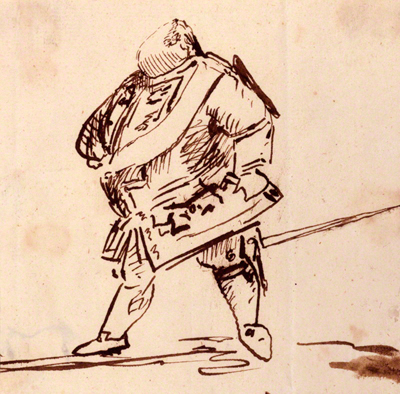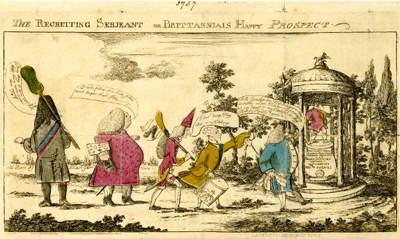George Townshend
George Townshend (later Viscount Townshend) was a witty and headstrong aristocrat who began his career in the military. Obtaining a commission in the army in 1744, he served with distinction, and, over the next 6 years, rose to the rank of lieutenant colonel. But with a mercurial personality that did not suffer fools gladly, Townshend was never shy about criticizing those whose competence he questioned. Not suprisingly, this led to open hostility between Townshend and his military superior, the Duke of Cumberland, and Townshend's eventual resignation from his post in 1750.

Duke of Cumberland [1750s]
© National Portrait Gallery, London
Townshend had always exhibited a knack for drawing, and during his military tenure used it effectively to sketch topography, fortifications, and maps. But beginning around 1750, he began to draw caricature sketches of people--officers, clergy, fashionable women. The Townshend family was one of the patrons of Arthur Pond, so it is likely that he was first exposed to caricature through Pond and his reproductions of Italian caricature. In any case, he was soon covering every scrap of available paper with caricature portraits of friends and enemies and circulating them among his friends and correspondents.
But it was in 1756-57 that Townshend began embedding his portrait caricatures into dramatic and narrative frames to make a political point, and thereby creating the prototype for satiric political caricature that would later be followed by Gillray and others. The Recruiting Sergeant, for example shows Fox acting as a sergeant gathering a pathetic group of recruits to create a new ministry while the Duke of Cumberland (for whom the ministry would be formed) appears ironically exalted in the Temple of Fame.

The Recruiting Sergeant [1757]
© Trustees of the British Museum
Sources and Reading
- Herbert Atherton, "George Townshend, Caricaturist" 18th Century Studies
- Herbert Atherton, "George Townshend Revisited: The Politician as Caricaturist," Oxford Art Journal